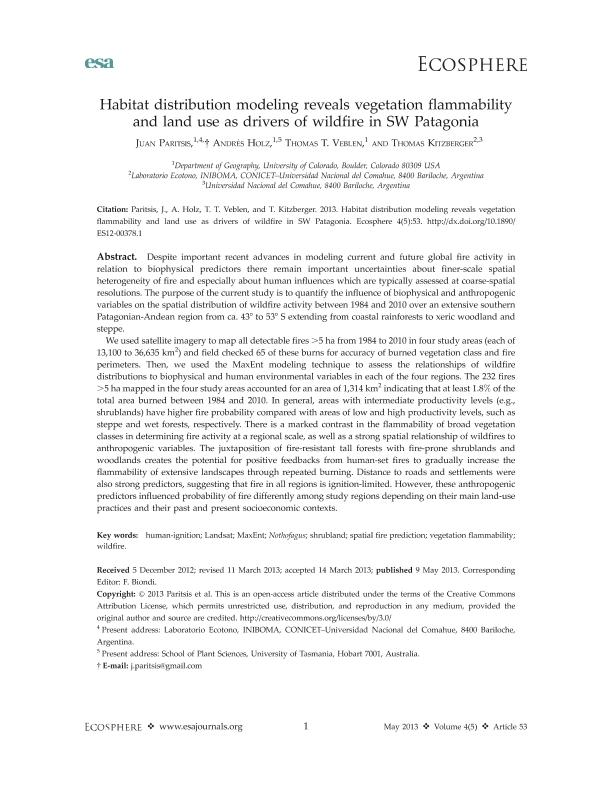Artículo
Habitat distribution modeling reveals vegetation flammability and land use as drivers of wildfire in SW Patagonia
Fecha de publicación:
05/2013
Editorial:
ESA
Revista:
Ecosphere
ISSN:
2150-8925
Idioma:
Inglés
Tipo de recurso:
Artículo publicado
Clasificación temática:
Resumen
Despite important recent advances in modeling current and future global fire activity in relation to biophysical predictors there remain important uncertainties about finer-scale spatial heterogeneity of fire and especially about human influences which are typically assessed at coarse-spatial resolutions. The purpose of the current study is to quantify the influence of biophysical and anthropogenic variables on the spatial distribution of wildfire activity between 1984 and 2010 over an extensive southern Patagonian-Andean region from ca. 43° to 53° S extending from coastal rainforests to xeric woodland and steppe.
We used satellite imagery to map all detectable fires > 5 ha from 1984 to 2010 in four study areas (each of 13,100 to 36,635 km2) and field checked 65 of these burns for accuracy of burned vegetation class and fire perimeters. Then, we used the MaxEnt modeling technique to assess the relationships of wildfire distributions to biophysical and human environmental variables in each of the four regions. The 232 fires > 5 ha mapped in the four study areas accounted for an area of 1,314 km2 indicating that at least 1.8% of the total area burned between 1984 and 2010. In general, areas with intermediate productivity levels (e.g. shrublands) have higher fire probability compared with areas of low and high productivity levels, such as steppe and wet forests, respectively. There is a marked contrast in the flammability of broad vegetation classes in determining fire activity at a regional scale, as well as a strong spatial relationship of wildfires to anthropogenic variables. The juxtaposition of fire-resistant tall forests with fire-prone shrublands and woodlands creates the potential for positive feedbacks from human-set fires to gradually increase the flammability of extensive landscapes through repeated burning. Distance to roads and settlements were also strong predictors, suggesting that fire in all regions is ignition-limited. However, these anthropogenic predictors influenced probability of fire differently among study regions depending on their main land-use practices and their past and present socioeconomic contexts.
Palabras clave:
Human-Ignition
,
Max-Ent
,
Nothofagus
,
Wildfire
Archivos asociados
Licencia
Identificadores
Colecciones
Articulos(INIBIOMA)
Articulos de INST. DE INVEST.EN BIODIVERSIDAD Y MEDIOAMBIENTE
Articulos de INST. DE INVEST.EN BIODIVERSIDAD Y MEDIOAMBIENTE
Articulos(SEDE CENTRAL)
Articulos de SEDE CENTRAL
Articulos de SEDE CENTRAL
Citación
Paritsis, Juan; Holz, Andrés; Veblen, Thomas T.; Kitzberger, Thomas; Habitat distribution modeling reveals vegetation flammability and land use as drivers of wildfire in SW Patagonia; ESA; Ecosphere; 4; 5; 5-2013; 1-20
Compartir
Altmétricas




